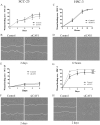Loss of Caveolin-1 Expression in Tumor Cells is Associated with Increased Aggressiveness and Cell Invasion in Oral Squamous Cell Carcinoma
- PMID: 37233885
- PMCID: PMC10513997
- DOI: 10.1007/s12105-023-01562-w
Loss of Caveolin-1 Expression in Tumor Cells is Associated with Increased Aggressiveness and Cell Invasion in Oral Squamous Cell Carcinoma
Abstract
Background: Changes in Caveolin-1 (CAV-1) expression are related to tumorigenesis. The aim of this study was to evaluate the role of CAV-1 in tumor progression in oral squamous cell carcinoma (SCC) tissue samples and the effect of CAV-1 silencing on two oral tongue SCC (OTSCC) cell lines (SCC-25, from a primary tumor, and HSC-3 from lymph node metastases).
Methods: Mycroarray hybridization, mRNA expression, and immunohistochemistry were performed on OSCC tissue samples and corresponding non-tumoral margin tissues. The effects of CAV-1 silencing (siCAV-1) on cell viability, membrane fluidity, on the expression of epithelial to mesenchymal transition (EMT) markers and on cell migration and invasion capacity of OTSCC cell lines were evaluated.
Results: Microarray showed a greater CAV-1 expression (1.77-fold) in OSCC tumors than in non-tumoral tissues and 2.0-fold more in less aggressive OSCCs. However, significant differences in CAV-1 gene expression were not seen between tumors and non-tumoral margins nor CAV-1 with any clinicopathological parameters. CAV-1 protein was localized both in carcinoma and in spindle cells of the tumor microenvironment (TME), and CAV-1 positive TME cells were associated with smaller/more aggressive tumors, independent of the carcinoma cells' expression. Silencing of CAV-1 increased cell viability only in SCC-25 cells. It also stimulated the invasion of HSC-3 cells and increased ECAD and BCAT mRNA in these cells; however, the protein levels of the EMT markers were not affected.
Conclusion: Decreased expression of CAV-1 by tumor cells in OSCC and an increase in the TME were associated with increased cell invasiveness and tumor aggressiveness.
Keywords: Caveolae; Caveolin-1; Epithelial-mesenchymal transition; Oral tongue squamous cell carcinoma; Silencing of the gene; Tumor aggressiveness.
© 2023. The Author(s), under exclusive licence to Springer Science+Business Media, LLC, part of Springer Nature.
Conflict of interest statement
The authors declare no potential conflicts of interest with respect to the research, authorship, and/or publication of this article.
Figures






References
MeSH terms
Substances
Grants and funding
LinkOut - more resources
Full Text Sources
Medical
Research Materials

